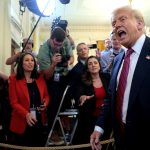The recent stock market roller coaster can be chalked up to a volatile cocktail of geopolitical tension, economic signals, and policy moves—none more influential than the ongoing tug-of-war between the United States and China. This high-stakes drama has sent markets swaying wildly, painting a picture of investor sentiment stretched thin between hopes for détente and fears of escalating conflicts. The dance between these two economic giants remains the gravitational center around which current market behavior orbits.
The Trade Tensions Tightrope
At the heart of this market caper lies the US-China trade relationship, a drama unfolding with sharper twists than a suspense thriller. Early in 2025, tensions flared dramatically as both nations slapped tariffs back and forth, triggering one of the most turbulent weeks Wall Street has seen in recent memory. The Trump administration’s aggressive tariff policies turbocharged this volatility, with sectors such as aerospace taking heavy hits—Boeing’s stock plummeted after China froze new aircraft orders, a perfect example of how political posturing translates directly to dollar losses on the trading floor.
Yet amid this chaos, a glimmer of hope appeared when the two nations struck a 90-day trade truce. This temporary ceasefire lifted investor spirits and propelled major indices like the S&P 500, Dow Jones Industrial Average, and Nasdaq into positive territory. The truce wasn’t just a pause in the tariff war; it opened windows for renewed negotiations and sparked rallies, especially in tech and consumer discretionary sectors. The Nasdaq even surged to fresh highs, buoyed further by positive economic data in the services sector and rising Chinese equities, showing that hope can be a powerful market mover—at least temporarily.
The Push and Pull of Market Sentiment
The market’s mood swings have been as dramatic as the headlines themselves. Moments of optimism often crashed under the weight of new tariff threats or retaliatory measures—like when China ordered the closure of a U.S. consulate and ramped tariffs to 125%, sending shockwaves through European and American markets. Yet such setbacks tended to be temporary. Resilience surfaced as traders rotated out of riskier pockets into value stocks, particularly banks, which were buoyed by strong earnings reports from giants like Bank of America and Citi.
Amid these oscillations, inflation data and monetary policy played their own critical roles. Mixed signals on inflation, especially a cooling Personal Consumption Expenditures (PCE) index, eased fears about aggressive Federal Reserve rate hikes. This, coupled with solid consumer sentiment, helped markets hold their ground even under the cloud of trade uncertainty. Treasury yields tracked this dance, often nudging lower during risk-on phases and reinforcing higher equity valuations. It’s a delicate balancing act, where every bit of inflation news or Fed commentary can ignite or deflate market bubbles.
Commodities and Geopolitical Wildcards
Adding more layers to this intricate market puzzle are commodity prices and geopolitical stressors. Crude oil prices, sensitive to global growth outlooks, took a dip amid fears of a slowdown, providing some breathing room to energy stocks and the broader market. However, volatility wasn’t far off—Russia-Ukraine tensions kept the energy sector on edge, injecting occasional bursts of uncertainty that investors had to factor into their calculations. These patchy influences underscore the complexity of modern markets, where a flare-up thousands of miles away can ripple through multiple sectors and asset classes instantly.
All these factors combine to sketch a vivid portrait of a market caught between hope and hesitation, risk and opportunity. Trade relations remain the lynchpin, influencing sectors as varied as technology, manufacturing, and finance. Despite recurring tariff battles igniting sell-offs, moments of diplomatic thaw and strong economic reports have repeatedly sparked recoveries and renewed investor confidence.
Navigating this churning landscape calls for a sober awareness of the balance between sudden geopolitical shocks and the lure of improving corporate earnings alongside potential monetary easing. This recurring theme of sharp drops followed by meaningful rallies captures the essence of a market still searching for stable ground amid persistent external pressures. Staying attuned to trade developments, inflation trends, and earnings reports will remain crucial for investors trying to read the complex signals emanating from policymakers and global events.
The recent market saga lays bare the intricate nexus of geopolitics and economic fundamentals shaping today’s investment climate. It’s a world that demands flexibility and vigilance, where fortunes can rise and fall on the back of tariffs, earnings beats, and shifting monetary tides. In this high-wire act, the savvy investor watches not just the charts but the headlines, knowing that in the game of markets, the aftershocks of geopolitical drama can echo long and loud.







